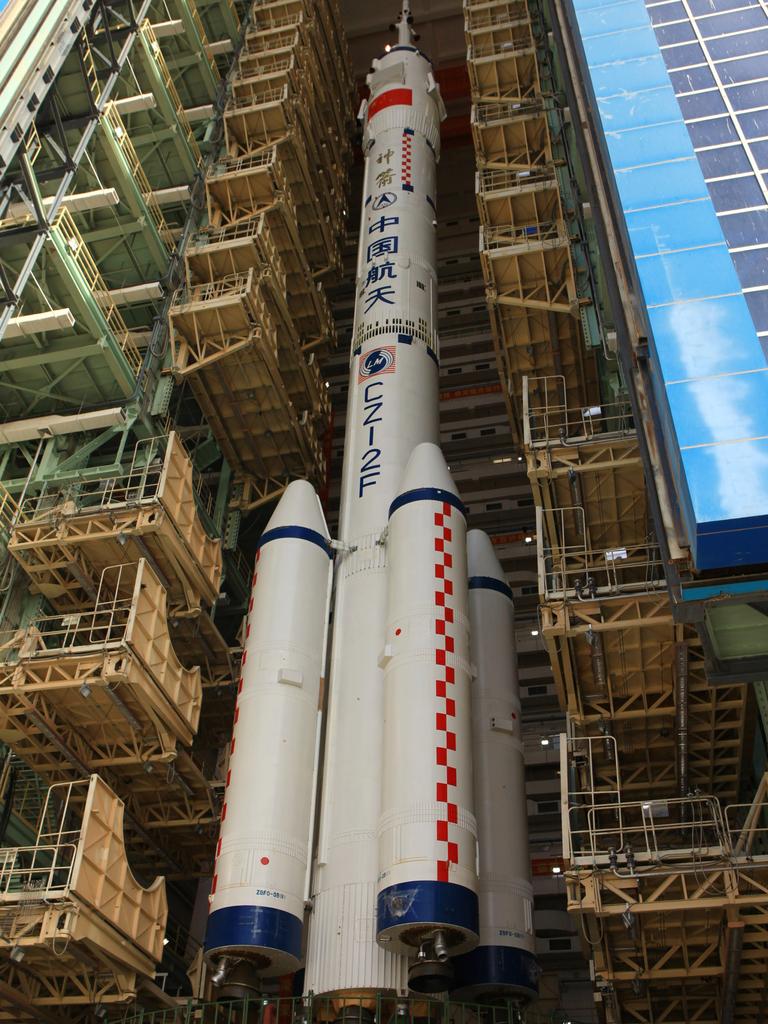China launched mystery robotic space plane into orbit for 2 days
It could have the capability to strike “anywhere on earth within half an hour” and it was secretly in orbit for two days. The new space race is on.

China has made a giant leap forward in the militarisation of space with the launch of a new robotic space plane.
State-run Chinese media at the weekend quietly announced: “My country successfully launched a reusable test spacecraft at the Jiuquan Satellite Launch Centre on the 4th.”
Xinhua news agency later reported the space plane had landed on Sunday at the Jiuquan Satellite Launch Centre in China’s northwestern Gobi desert after two days in orbit.
China successfully launched a reusable experimental spacecraft with a Long March-2F rocket from Jiuquan Satellite Launch Center Friday. The spacecraft will test reusable technologies during its flight, providing technological support for the peaceful use of space. (file pic) pic.twitter.com/h3DTlIQiD6
— China Science (@ChinaScience) September 4, 2020
It did not detail the nature of the craft, its mission or its potential uses. Instead, it stated, “It will carry out reusable technology verification as planned to provide technical support for the peaceful use of space.”
RELATED: Russia’s new spacecraft a frightening step towards weaponising space

RELATED: Space clean-up drones could have military implications
But the Communist Party-run Global Times reported last night the craft would “transform” the balance of power in space for both civilian and military use.
“China’s authorities have not revealed any intention of military use for the vehicle, but observers stressed that just as the US Air Force’s X-37B claimed to have the capability to strike anywhere on Earth within half an hour, China should at least have that capability,” the article reads.
MYSTERY MISSION
No photographs, videos or explanatory graphics were released to accompany what was an unusually low-key launch and flight. No launch date was announced. No mission profile was detailed.
But international expectations had been high that China’s space agency would be testing its shuttle-like uncrewed orbiter after an unusually large five-metre diameter nose cone was spotted atop a heavy Long March 2F rocket last month.
Now then -- this could be something exceptional. The rumours are that inside this exceptional payload fairing atop a CZ-2F is a CASC spaceplane, launching from Jiuquan Friday. Source: 俊了个锅 via 林晓弈。 https://t.co/qs6VRfzQoP https://t.co/OESvzyDyEl pic.twitter.com/ZPnpwAIfyO
— Andrew Jones (@AJ_FI) September 3, 2020
While China has released no detail as to the size or shape of the space plane, international analysts speculate it may follow similar principles to that of the US Air Force’s X-37B.
The design is similar in principle to that of the Space Shuttle – a winged, cargo-carrying craft capable of operating in orbit before gliding back to Earth. The intention is to cut costs and waste, as well as to provide a rapid-turnaround service to space. And the cargo bay allows a diverse range of payloads to be carried and tailored to specific missions.
This Boeing-built robotic space plane was first launched in 2010 and has since conducted several secretive missions in orbit lasting up to 780 days.
It’s currently again in orbit on what is its sixth mission.
RELATED: China’s secret ‘submarine cave’ revealed

The success of the X-37B prompted Beijing to declare in 2017 that it would put its own space plane in orbit by 2020. The weekend’s flight appears to have achieved this goal.
The joint US-Canadian NORAD space surveillance command has confirmed that a “PRC Test Spacecraft” had successfully reached orbit.
NEW ARMS RACE
Chinese media has dropped few hints as to the nature of its new spacecraft.
In 2007, a winged flying body was seen attached to an H-6K strategic bomber before undergoing glide tests. Dubbed ‘Project 863-706’, this was likely part of a development program that led to the weekend’s launch.
But the Global Times last night allowed its report to indulge in some speculation:
“The vehicle could be equipped with robotic arms to conduct maintenance and supply missions for on-orbit spacecraft such as satellites. And in return, Chinese satellites could enter a new age of modularisation, further tap into the potential of space application.”
The prospect of controlled spacecraft moving about in orbit, going from satellite to satellite has the world’s militaries nervous.
On one level, such technologies allow expensive malfunctioning satellites to be repaired or even returned to Earth. Others could be updated, or even refuelled.
But there’s also the potential for sabotage. Sensitive equipment could be destroyed. And technological secrets could be stolen.
Beijing has confirmed it is pursuing an artificial intelligence controlled spacecraft to “scavenge” space. “We prefer not to talk about it publicly,” Space Technology deputy director Luo Jianjun of Xian University said last year. “Most details remain secret because of the technology’s potential military applications.”


The space plane test flight is the latest in a series of Chinese space achievements. It put its first astronaut into orbit in 2003.
Late last year, it became the first nation to successfully land a probe and rover on the far side of the Moon. Its first Mars rover mission is currently on its way to the red planet.
Jamie Seidel is a freelance writer | @JamieSeidel




